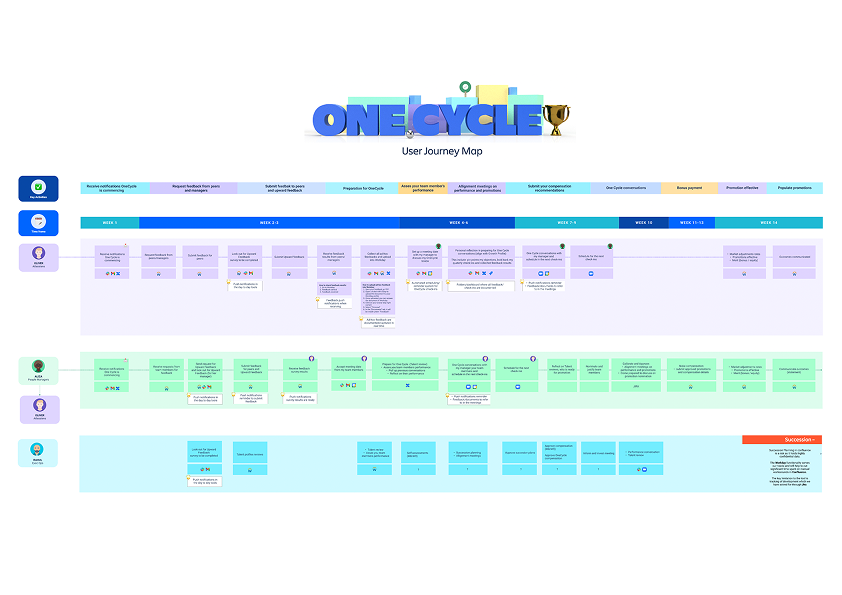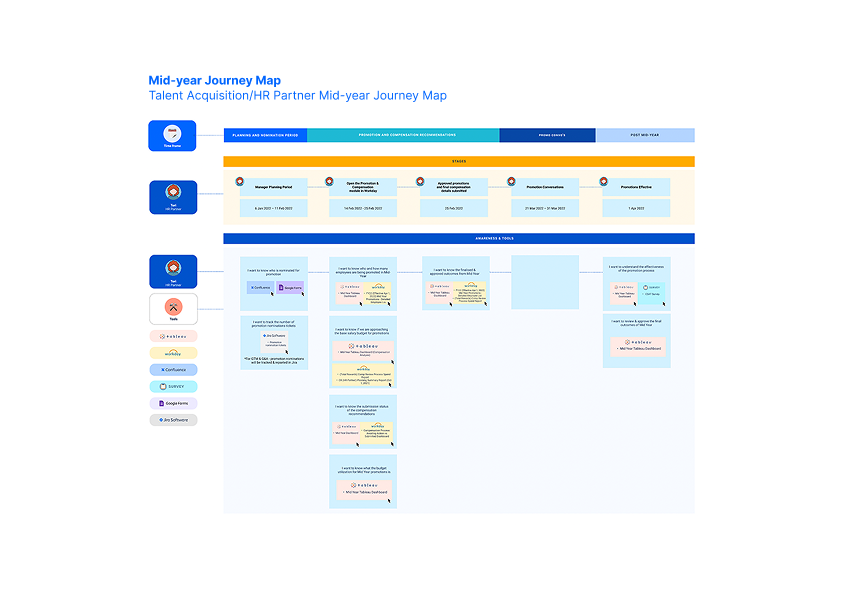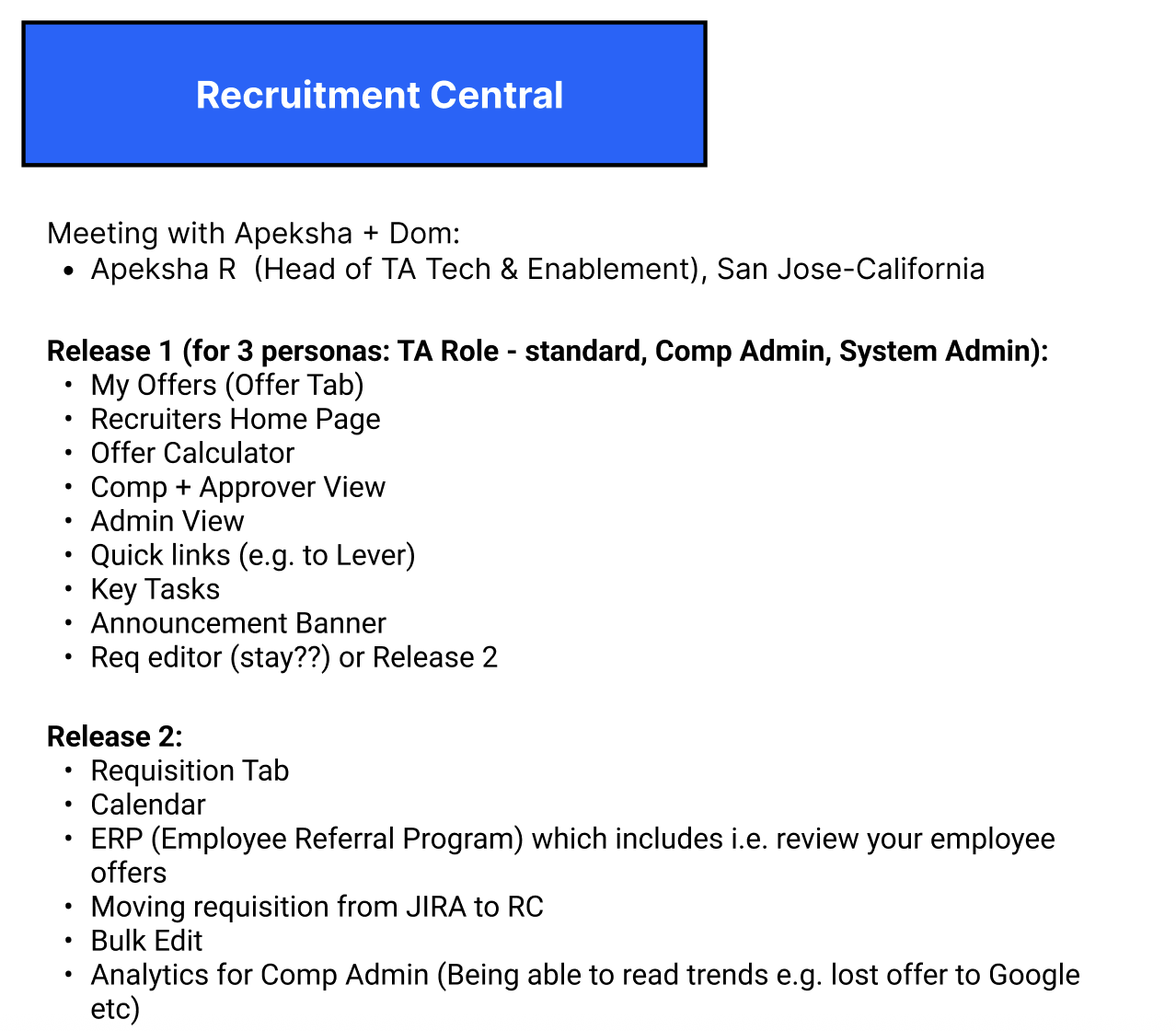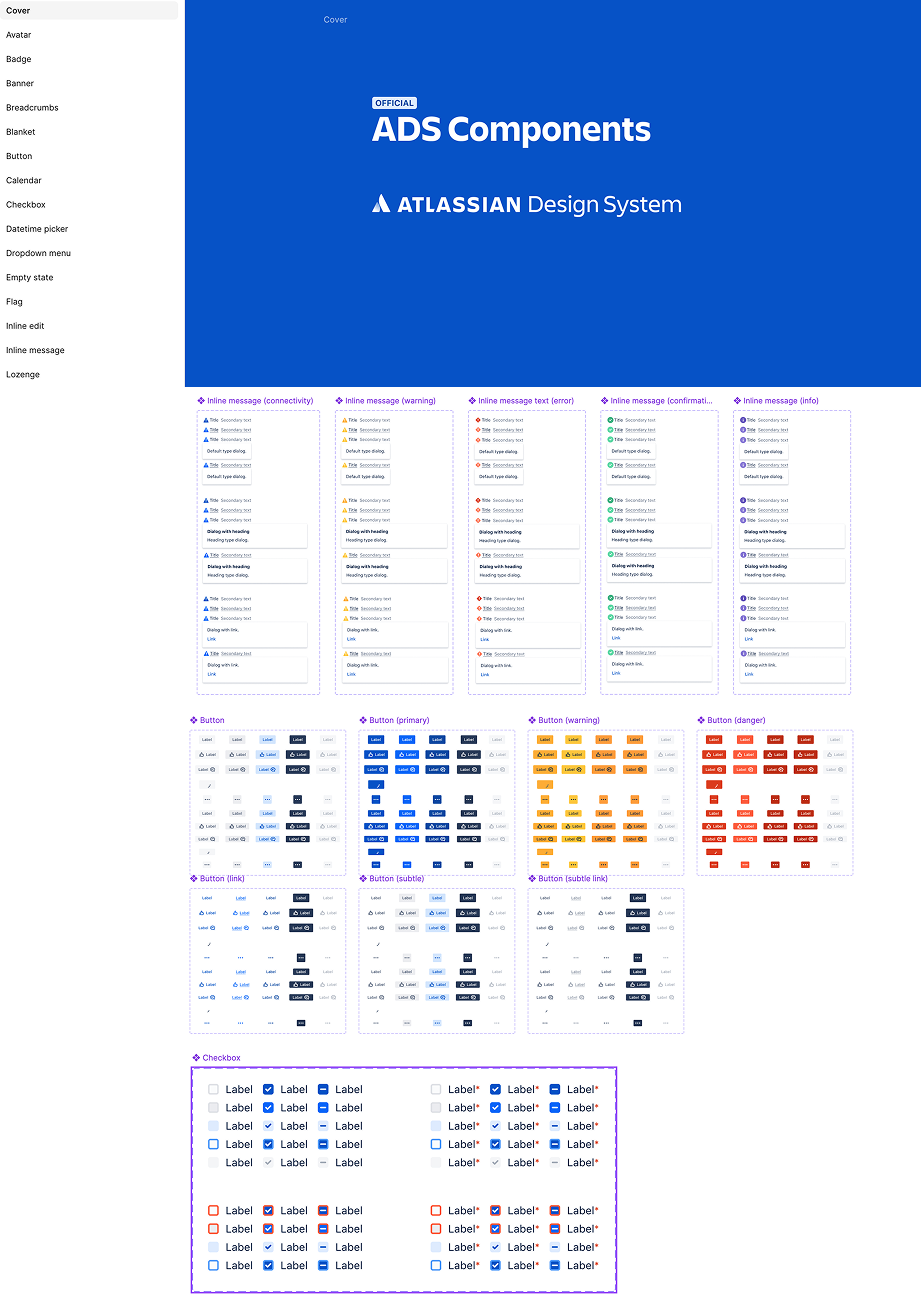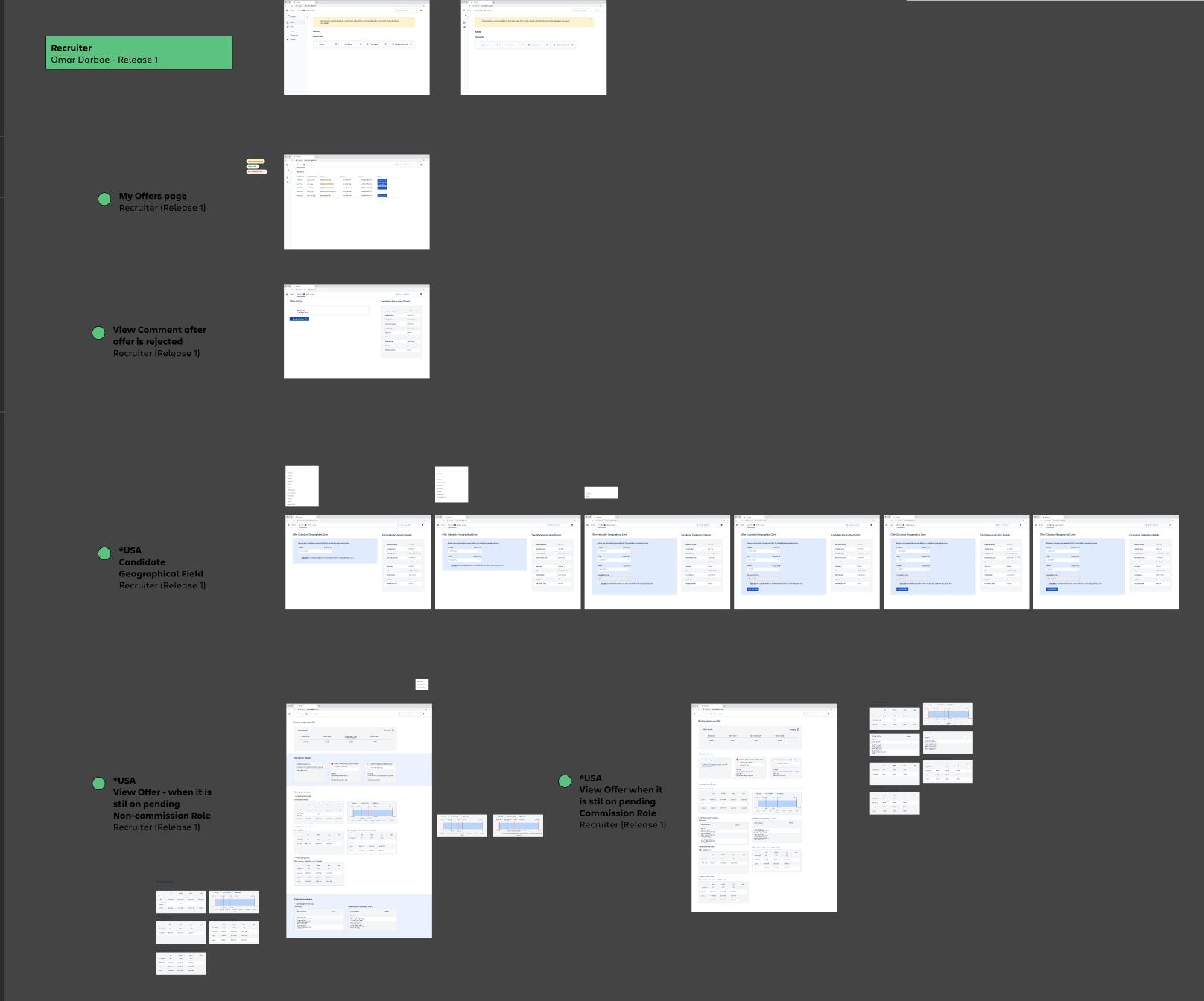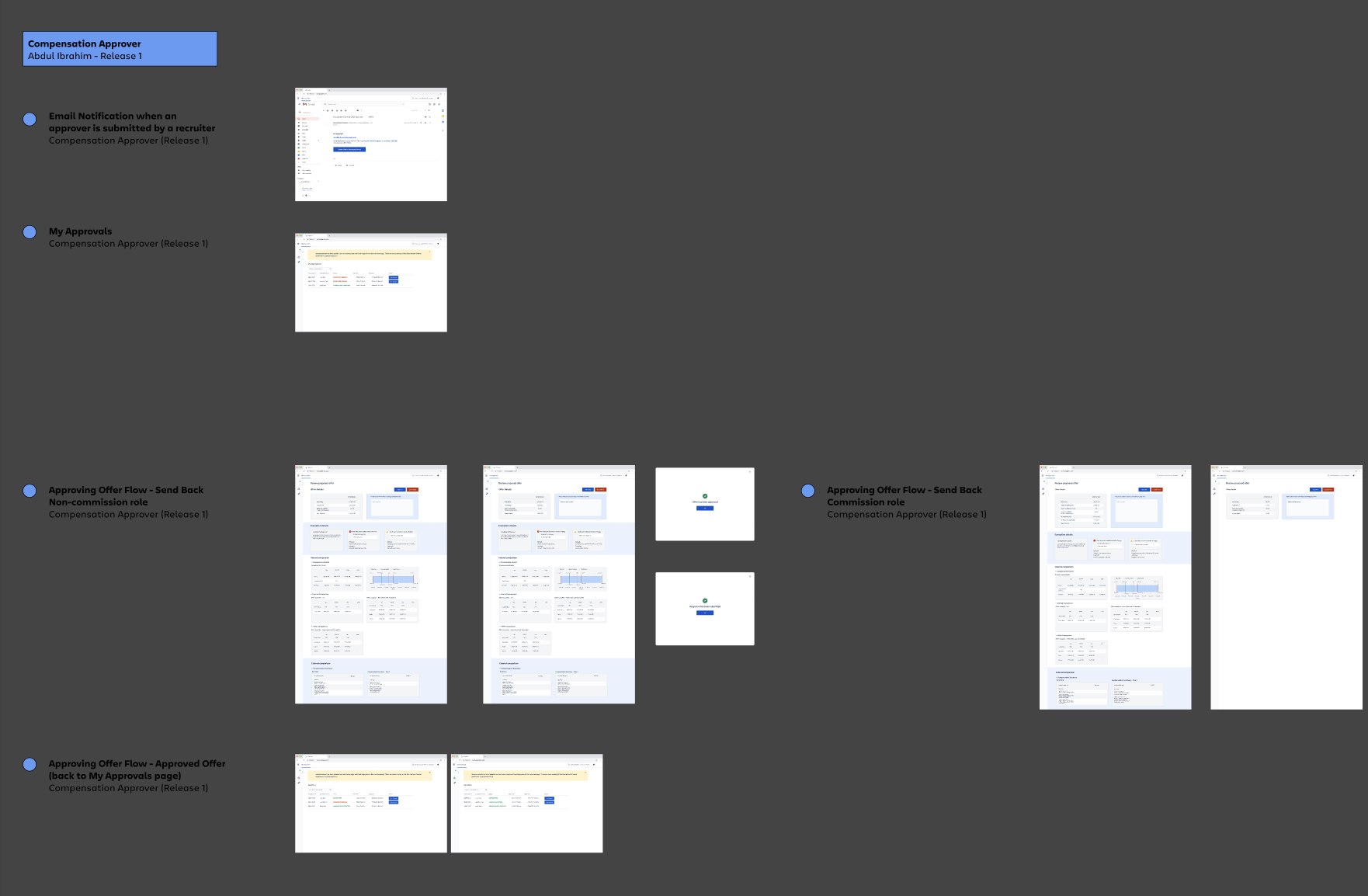Recruitment Central
Revolutionising recruitment for tomorrow's talent
Client
A Nasdaq-listed global SaaS company offering digital tools for project management, team collaboration, and software development.
Product
Hiring resource tech (HR Tech) product that streamlines and accelerates hiring.
Stakeholders
Recruiters, Hiring Managers, FP&A, Product Owner
Year
2021-2022
My Role
End-to-end UX/UI Designer (Research, Wireframes, Prototyping, Usability Testing, Hand-off to developers)
My Contributions
Led the end-to-end experience design process, from research to prototype in cross-functional team (project managers, developers, business analysts, and stakeholders).
Conducted user research and workshops to gather insights and define requirements.
Designed wireframes and prototypes, ran usability tests, and iterated on solutions.
Delivered developer-ready wireframes, ensuring a seamless handover and implementation.
Background
The project aimed to expedite the hiring process. The primary objective was to hire 1,000 staff globally in FY24 while planning for 5,000 by 2026 in preparation for the launch of its new office in Sydney’s Tech Central.
Workshop within the consulting project team
Our cross-functional consulting team (product manager, business analyst, delivery manager, change partner, and myself as product designer), we ran an internal workshop to uncover pain points, align on goals, and understand the operational realities behind the 25,000-hire target.
The workshop revealed the client’s pressure of delivering 25,000 hires has created operational strain, capacity gaps, and misalignment across teams, highlighting the need for clearer processes, better coordination, and more scalable systems for the client. My particular responsibility is on the product design of the new HR Tech - Recruitment Central.
Problem Statement
How might we employ top-tier talent by making our hiring process faster, more collaborative, data-informed and competitive?
Discover
Quantitative Insights
To better understand the current hiring process and quantify its inefficiencies, I gathered key metrics from the Talent Acquisition team, including:
Average time-to-offer: 40–45 days from initial interview to offer acceptance, with delays largely caused by multi-step compensation approvals.
Candidate drop-offs per stage: Approximately 25% of candidates withdrew before receiving an offer, often due to slow response times.
Volume of cross-team follow-ups: On average, recruiters sent 10–12 Gmail emails per candidate to chase approvals or status updates, along with numerous Slack messages.
Frequency of manual compensation recalculations: FP&A spent roughly 6–8 hours per week per recruiter recalculating offers in Excel, with frequent errors due to complex country/state pay bands.
This data highlighted clear inefficiencies and validated the need for automation, improved transparency, and faster approval cycles.
User Interviews
To begin my process and uncover more detailed insights, I conducted interviews with the same participants from the workshop: two Talent Acquisition specialists, two FP&A professionals, and one Hiring Manager.
Sample interview questions included: “Which steps do you find redundant or frustrating?”, “Are there tasks you feel could be automated or simplified?”
Key Challenges/Insights:
Communication silos between teams made it hard to track candidates’ hiring status: Different teams and departments, including recruiters, hiring managers, FP&A, and other HR agencies, operated in isolation. This hindered collaboration, caused delays, miscommunication, and led to inconsistencies in the hiring workflow.
Using disconnected tools created inefficiencies in hiring: The current process relied on multiple disintegrated tools like email, Excel sheets, Slack, Workday, Tableau, and ICIMS. This resulted in lengthy, complex procedures and sometimes led to losing potential applicants to competitors.
Limited access to salary data made offering competitive compensation difficult: Without comprehensive and reliable salary data, it was challenging to determine competitive compensation packages. This lack of market insight made it harder to attract and retain top-tier talent
Facilitating User Story Workshop and Ideation
Participants: Two FP&A’s, Two TA’s and One Hiring Manager.
I facilitated user story workshop to understand personas with an objective in creating features that they need and to define user requirements.
The workshop uses the format, "As a [Persona], I want to [Need] so that [Purpose]." Ensuring the team fully understands each others’ objectives and motivations.
Key findings:
The hiring process is fragmented and manual, with duplicated tasks, scattered data, and unclear next steps causing delays and inefficiencies.
Collaboration and approvals are slow, with communication breakdowns between Talent Acquisition, FP&A, and Hiring Managers, limiting visibility and accountability.
Synthesised findings are used to ideate
How might we employ top-tier talent by making our hiring process faster, more collaborative, data-informed and competitive?
Features from ideation
Real-time offer calculator
Embedded compensation bands
A central candidate dashboard
Candidate’s status
Competitive Analysis
To prepare for the design - I carried out a quick across three key platforms: Workday, Tableau and Employment Hero. I focused on how these tools handled compensation workflows, approval flows, hiring visibility, salary benchmarking features.
From this scan, I identified several patterns and opportunities that could be integrated into the solution. For example:
Workday: strong in structured workflow automation and consistent approval logic, but can be complex and hard to navigate.
Tableau: excellent for real-time data visualisation to support compensation decisions, though it requires manual data prep and is less integrated into hiring workflows.
Employment Hero: clear and simple interface reduces friction for recruiters and hiring managers, but lacks advanced workflow automation and analytics features.
These insights highlighted opportunities for the solution, such as integrating automated compensation logic, creating transparent and traceable approval flows, and providing real-time market data, all within a unified, streamlined interface.
Define
Personas
I then created three core personas to represent the primary user groups: Talent Acquisition, who value efficiency and smooth candidate management; Hiring Managers, who need clear information to make fast, confident decisions; and FP&A, who prioritise accuracy, transparency, and financial integrity. Together, these personas illustrate the need for a tool that balances speed, clarity, and reliable data across the hiring process.
User Journey
Based on all gathered interviews and documents provided with the key personas: Recruiters, Hiring Managers, FP&A analysts, and candidates, I mapped the end-to-end hiring journey, from job requisition creation through to final offer approval.
Users navigate multiple disconnected steps to make hiring decisions. They manually collect data from various sources, track candidate updates, and manage approvals through separate channels. This fragmented workflow often leads to delays, unclear next steps, and limited visibility across teams, slowing hiring decisions and making interdepartmental collaboration more challenging.
Key features
Based on all findings; including ideation, these key features were prioritised based on both business and user needs. Due to time and budget constraints, not all features could be included in a single release. The final feature set was determined collaboratively by the Head of Tech Enablement/product owner, the project manager, and myself, through multiple discussions with stakeholders to balance user needs and available resources.
Main features and its functionality:
Offer Calculator:
Equipping recruiters with the capability to assess candidate compensation while concurrently displaying salary benchmarks for the same job title within the industry, this tool streamlines the comprehensive evaluation of whether the proposed compensation aligns with budgetary considerations. If adjustments are warranted, recruiters can promptly initiate approval requests with FP&A.
Comprehensive Compensation Bands:
Providing recruiters the capacity to evaluate candidate compensation while concurrently presenting salary data for the corresponding job title across industry competitors, this feature simplifies the process of assessing whether the proposed compensation adheres to budget constraints. In cases requiring adjustments, recruiters can efficiently initiate approval requests with FP&A.
Hiring Status:
Offering users a valuable advantage by providing real-time insights into the current applicant status, this feature eliminates information silos. It promotes seamless collaboration among all relevant stakeholders, including recruiters, hiring managers, and applicants themselves. This heightened transparency and cooperation significantly enhance the feasibility of the entire recruitment process, ensuring its smooth and efficient operation.
Offer Approval Settings:
Serving as a communication conduit between recruiters and FP&A, this functionality enables recruiters to request FP&A's input on candidate compensation, expediting the approval or rejection process. Also acts as a setting where FP&A can be assigned to different types of Countries and States/Zones. For example, compensation in the United States varies amongst states like Georgia vs Texas.
User Interface
For UI design, I aligned with the company’s existing design system, using standardised components such as tables, badges, buttons, and modal interactions to maintain consistency across teams.
When new components were required, I collaborated closely with engineers and the company’s UI design team, often iterating to avoid creating new components whenever possible to ensure seamless implementation.
Develop
Early Flow and Wireframe Sketches
I begin by mapping the user flow to understand how users will navigate the product. Early wireframe sketches visualise key screens and interactions, focusing on layout, hierarchy, and functionality rather than visual design. These wireframes go through multiple iterations based on stakeholder feedback.
Usability Testing
Following this, I conducted usability testing with end users from the target audience to gather precise feedback, which informed further iterations. I ran usability testing sessions with 9 users across TAs, Hiring Managers, and FP&A.
Tasks included; calculating an offer, comparing salary bands, requesting compensation approval, tracking a candidate’s hiring status.
Key insights:
Recruiters valued speed and clarity; they wanted real-time visibility into candidate status as the first thing they see, enabling them to prioritise actions efficiently.
Hiring Managers needed visibility into candidate progress without being overloaded with data and preferred at-a-glance dashboards showing only actionable items.
FP&A emphasised the importance of salary comparison bands with other companies.
During testing, several design decisions required pushback and careful negotiation with the Product Owner:
The offer calculator layout initially used a single column. While the Product Owner preferred a clean linear layout, usability testing data showed a two-column layout reduced scrolling and improved efficiency.
Implementing salary comparison bands with other companies was initially questioned due to technical complexity, budget, and time constraints. I championed the users’ needs, alongside FP&A and Talent Acquisition, to ensure this feature was prioritised, as it was critical for maintaining competitiveness.
There are other minor features that were still missing was requested such as toggle between Part-time and Full-time employees, filter for non-commission and commission roles, filter of job functions.
Deliver
Talent Acquisiton Dashboard
The TA’s dashboard streamlines job requisition management and candidate offer calculations, replacing the previous Excel-based process and expediting hiring workflows. It also enables offer comparisons with the broader job market to ensure hiring competitiveness. In cases of budget exceedance, the dashboard allows a recruiter to make approval requests addressed to FP&A.
FP&A Dashboard
The FP&A Dashboard streamlines the review and approval process of candidates for FP&A. When a recruiter sends FP&A a job offer for approval, FP&A has the option to “Approve” or “Send Back” a job offer with comments. The dashboard allows FP&A to view all outstanding offers and their details, ensuring swift and informed decision-making. The dashboard empowers the client to swiftly execute the hiring process and secure top talent before they consider exploring opportunities with rival employers.
Handing off for developers
Once final prototype is done - I walked through prototype to the developers team. I prepared a UI specification annotation, for success/error validations, components library (existing to refer to). While building the product we had cadence weekly for any questions and checking every flow/feature is the same as the prototype.
Results
We tested the product with the direct users (Hiring Managers, Recruiters Team, and FP&A), about 9 users in total. The feedback was very positive, with an average SUS rating of 4.5/5, highlighting improved efficiency in the hiring process.
The product is expected to reduce the average time-to-offer from 40–45 days to under 30 days (a 25–35% reduction). This faster turnaround is projected to significantly lower candidate withdrawals, aiming to reduce the current 25% drop-off rate to below 10%.
The company has grown from 6,000 employees in 2021 to 12,500 employees in 2025 which is a 108% increase (approx. 20% CAGR). In Australia alone, the workforce has expanded to 4,600 employees, reinforcing strong regional growth and ongoing momentum toward 2026 scaling targets.
Personal Takeaways
Some key personal takeaways from the engagement included:
The importance of collaboration
I learned how to better manage responsibilities across disciplines to avoid overlapping work. Managing overlapping responsibilities strengthened my communication skills and highlighted the importance of clear role definition in keeping the project on track.Contributing to Australia’s leading tech company
It was a privilege to play a role in the growth of one of Australia’s most prominent tech companies. Being part of its success story has been both meaningful and rewarding.Lifelong learning and innovation in UX design
The dynamic nature of UX design demands continuous learning and adaptability. Staying current with emerging trends and technologies is essential to creating impactful user experiences and driving successful outcomes.








